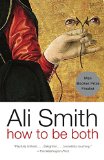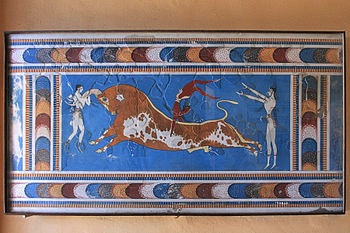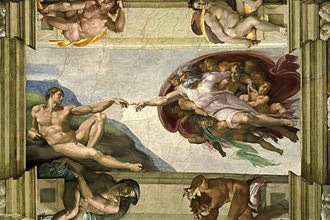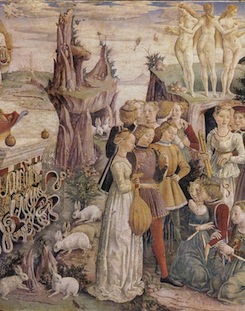Summary | Excerpt | Reading Guide | Reviews | Beyond the Book | Read-Alikes | Genres & Themes | Author Bio

Critics' Opinion:
Readers' Opinion:
First Published:
Dec 2014, 384 pages
Paperback:
Oct 2015, 384 pages
 Book Reviewed by:
Book Reviewed by:
Naomi Benaron
Buy This Book
This article relates to How to be Both
Early Fresco Painting
 Ali Smith's How to Be Both was inspired by a book she found about frescoes. Fresco, meaning "fresh" in Italian, is the technique of painting in water-based pigment on wet plaster so that the plaster, paint and wall fuse into a single entity. The earliest known examples date from c. 1500 BCE, on the island of Crete, the center of Minoan civilization. One of the more stunning fresco paintings is of a Flying Bull at the Palace of Knossos, which was the seat of Minoan culture. The painting shows a bull in mid leap with a man at his horns, another leaping over his back, and a third behind the bull's kicking feet. The work, with its sweeping curves and detailed and accurate muscularity of both men and bull, exhibits a sense of action and momentum, and perhaps depicts a sporting event of the times.
Ali Smith's How to Be Both was inspired by a book she found about frescoes. Fresco, meaning "fresh" in Italian, is the technique of painting in water-based pigment on wet plaster so that the plaster, paint and wall fuse into a single entity. The earliest known examples date from c. 1500 BCE, on the island of Crete, the center of Minoan civilization. One of the more stunning fresco paintings is of a Flying Bull at the Palace of Knossos, which was the seat of Minoan culture. The painting shows a bull in mid leap with a man at his horns, another leaping over his back, and a third behind the bull's kicking feet. The work, with its sweeping curves and detailed and accurate muscularity of both men and bull, exhibits a sense of action and momentum, and perhaps depicts a sporting event of the times.
In first century CE Pompeii and Herclaneum, fresco art was used to decorate the walls of otherwise austere and small homes. They typically depicted ornate gardens, sweeping vistas of the countryside, and events from daily life, as well as mythological subjects, and paintings of a sensual and sexual nature. The eruption of Mount Vesuvius in 79 CE preserved the frescoes in remarkably good condition. In contrast to the frank expression of Pompeian frescoes, 2nd and 3rd century CE frescoes by Roman Christians portrayed biblical themes and religious symbols and are far more restrained.
Italian Renaissance Frescoes
 Fresco painting played a dominant role for Italian Renaissance masters. They were primarily religious in theme, the most famous example being the Sistine Chapel. Artists including Ghirlandaio, Signorelli, Perugino, and Botticelli contributed to the walls. Most famously, Michelangelo painted the vault of the chapel's ceiling, completing the 4-year work in 1512. The frescoes are filled with vivid and intense colors, and Michelangelo's figures show a detailed and accurate knowledge of anatomy.
Fresco painting played a dominant role for Italian Renaissance masters. They were primarily religious in theme, the most famous example being the Sistine Chapel. Artists including Ghirlandaio, Signorelli, Perugino, and Botticelli contributed to the walls. Most famously, Michelangelo painted the vault of the chapel's ceiling, completing the 4-year work in 1512. The frescoes are filled with vivid and intense colors, and Michelangelo's figures show a detailed and accurate knowledge of anatomy.
School of Ferrara
The city of Ferrara was ruled by the Este family between the 13th and 16th centuries. During that time, arts and culture flourished. Leonello d'Este, who ruled from 1441 to1450, was well known as a great humanist and patron of the arts. The Ferrarese school of art flourished predominantly under his rule and continued under the rule of his brother, Duke Borso d'Este. The leading masters were Cosme Tura, known as the founder of the school, Francesco del Cossa, and Ercole de' Roberti, who was del Cossa's apprentice. Speaking of del Cossa, Edmund Gardner, author of The Painters of the School of Ferrara, states, "His feelings for movement and power of representing it are considerably greater than Tura's; his figures and types . . . are less uncouth, and his drapery is disposed in less stiff and more natural folds."
del Cossa and the Frescoes at the Palazzo Schifanoia
The Palazzo Schifanoia, which translates as The Palace of Not Being Bored, was a hunting lodge belonging to the House of Este. Sometime after 1465, Duke Borso d'Este commissioned artists of the Ferrara school to construct, in the main hall, a series of allegorical frescoes related to the calendar months and the associated zodiac signs.
It is fairly certain that the artists responsible for the Salone dei Mesi (Room of the Months) are Cosme Tura, Francesco del Cossa, and Ercole de' Roberti. Del Cossa (a central character in Smith's How to Be Both) painted the frescoes for March, April, and May. He was born c. 1430, died c. 1477, most likely of the plague, and disappeared into anonymity. That we know about the frescoes at all is serendipitous. After the decline of the House of Estes, the Palazzo was sold. Its condition deteriorated, and it was used first as a barn and second as a tobacco factory. In the 1800s, the whitewash began falling off the factory walls, and the workers noticed, as Ali Smith says in an article, "eyes and bits of faces peeking out at them." The frescoes were restored and assumed to be the work of Cosme Tura. Then, in the late 1800s, an art historian named Adolfo Venturi stumbled on a letter written by del Cossa to Duke Borso. In it, he demanded equitable pay for his work. Again quoting Smith, "It's apparently the first recorded incident of an artist asking to be paid his proper worth – or declaring a kind of economic vanity, depending on which way you look at it." Since his rediscovery, works of del Cossa have been identified in Bologna and Ferrara, and one hangs in the National Gallery in London.
 What is both remarkable and groundbreaking about del Cossa's frescos in the Room of Months is his fusion of Greek, Asian, Middle Eastern, and Christian mythology and culture. His figures are bold and playful and have about them a sense of magical realism. Quoting Giorgio Agamben is his article on del Cossa's frescoes, Jan Verwoert says that del Cossa's depictions of the months are, "'signatures' of a mystical energy constellation. They both mark and channel its force." The Palazzo has been restored and is now open to tourists. We are fortunate to have them back and more fortunate still that Ali Smith found them and was inspired to write her remarkable and groundbreaking novel, How to Be Both.
What is both remarkable and groundbreaking about del Cossa's frescos in the Room of Months is his fusion of Greek, Asian, Middle Eastern, and Christian mythology and culture. His figures are bold and playful and have about them a sense of magical realism. Quoting Giorgio Agamben is his article on del Cossa's frescoes, Jan Verwoert says that del Cossa's depictions of the months are, "'signatures' of a mystical energy constellation. They both mark and channel its force." The Palazzo has been restored and is now open to tourists. We are fortunate to have them back and more fortunate still that Ali Smith found them and was inspired to write her remarkable and groundbreaking novel, How to Be Both.
Flying Bull fresco, courtesy of Lapplaender
The Creation of Adam portion of Michelangelo's Sistene Chapel frescos, courtesy of Artworksforever
Allegory of April fresco by Franceaco del Cossa, Courtesy of File Upload Bot (Eloquence)
Filed under Music and the Arts
![]() This "beyond the book article" relates to How to be Both. It originally ran in January 2015 and has been updated for the
October 2015 paperback edition.
Go to magazine.
This "beyond the book article" relates to How to be Both. It originally ran in January 2015 and has been updated for the
October 2015 paperback edition.
Go to magazine.





The Flower Sisters
by Michelle Collins Anderson
From the new Fannie Flagg of the Ozarks, a richly-woven story of family, forgiveness, and reinvention.

The House on Biscayne Bay
by Chanel Cleeton
As death stalks a gothic mansion in Miami, the lives of two women intertwine as the past and present collide.

The Funeral Cryer by Wenyan Lu
Debut novelist Wenyan Lu brings us this witty yet profound story about one woman's midlife reawakening in contemporary rural China.
Your guide toexceptional books
BookBrowse seeks out and recommends the best in contemporary fiction and nonfiction—books that not only engage and entertain but also deepen our understanding of ourselves and the world around us.